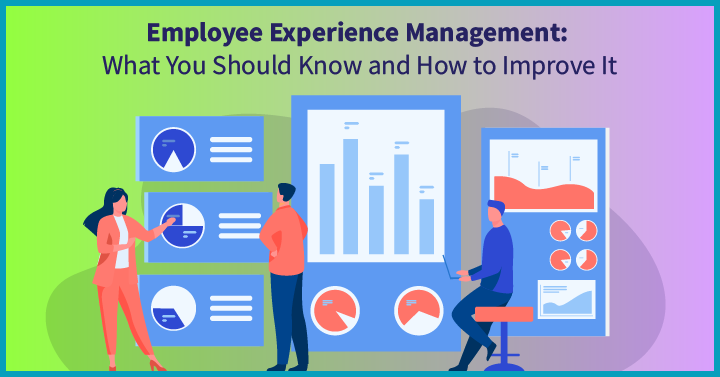The moment an employee walks through the doors all the way to when they decide to leave the company, every experience and interaction is what employee experience management refers to.
“In a world where money is no longer the primary motivating factor for employees, focusing on the employee experience is the most promising competitive advantage that organizations can create.” – Jacob Morgan, author of The Employee Experience Advantage
Let's dive in to learn more on what employee experience management is and how it can positively impact the workplace.
1 What Is Employee Experience Management?
Employee experience management is the deliberate manner in which every touchpoint an employee goes through by an organization is designed. This means that everything from the first recruitment post all the way to their last day on the job is covered under this. The three major factors in employee experience management are technological, physical, and cultural.
Employee experience management is important in order to be able to build effective teams and retain top talent. There are multiple factors that define employee experience. The three that take center stage are:
- Technological environment: More than ever before employees are looking to have a great technological experience. Technology plays a huge role in ensuring that work is done in an effective manner. As an employer ask yourself- “Do my employees have the requisite technology tools to complete a task successfully? “
- Physical environment: This refers to the actual setup around an employee when they walk into an office. Are the surroundings clean? Inviting? Do they have access to fresh food and water and ways to blow some steam off within the workplace? If you are operating out of a remote set up then the questions change to -Do they have the required flexibility in their schedule to manage their chores as well as office work easily”?
- Culture: Culture is an amalgamation described by the following questions- Do employees trust the leadership? Do they feel supported by their managers? Do they feel like their opinions hold value? All of these are aspects of the workplace that need to be optimized by the HR and managers to provide a good employee experience.
2 Why Is Employee Experience Management Important?

Employees are the backbone of any business as they carry out a majority of business functions like improving performance, maintaining customer relationships, and helping build a strong brand in your niche. So, employee experience management is a necessity as it will impact how employees work on a day-to-day basis. A good employee experience leads to optimal productivity while the inverse is true for a negative experience.
While on the surface it sounds like a simple enough thing. To provide consistent favorable experiences to your employees you need to have a strategy in place. It requires ongoing monitoring and management.
3 What Are The 5 Stages of Employee Experience?

3.1 Attraction
The first step is to attract top talent. There is a massive shortage of skilled workers for many businesses at this time and it is more important than ever to attract talent.
How do you do this?
By creating a brand for your company. Strengthen your social media presence and showcase everything from your employee recognition programs to initiatives for growth.
3.2 Recruitment
This is the stage where you interact with potential employees and build relationships a.k.a recruitment. Considering these are the people who will eventually join your company it is important that you present a compelling picture of your company culture and be clear about what their role in the company will be. It is only then you will be able to hire someone who has the right knowledge and skills and will be the right fit for the organization.
3.3 Onboarding
First impressions are everything when it comes to an employee experience. So, keeping this in mind you have to make sure that when they join your company you make them feel supported and provide a positive experience from the get-go. This includes introducing them to their direct co-workers, providing them with the right technology to help them excel, and executing all admin tasks that go along with onboarding a new employee.
3.4 Development & Retention
Once someone has joined your organization the next step is to make sure that you don’t forget about them. Connect and communicate with them on a regular basis and understand what you can do to help boost their productivity and help them excel at their job. Research has shown that people who are happy and engaged are more likely to stick around.
3.5 Exit
Even though you might want to keep employees engaged and retain them, there are always going to be departures in an organization. It is important that you work towards maintaining a positive relationship with every employee who is leaving. This will remove any chance of a void and aid in a peaceful transition of roles, responsibilities, and knowledge. This will also help keep the door open in case they ever want to return to the organization.
4 Essentials of an Employee Experience Strategy
4.1 Focus On Communication
Communication is essential in every organization. In large organizations, the biggest problem is that more time is spent establishing communication with stakeholders, and media and not with the employees.
Provide your employees with a platform to communicate both good as well as bad news, maintain transparency, and celebrate accomplishments that take place both in their professional as well as personal lives.
4.2 Always Respond to Feedback
Collect feedback from your employees and when you get it, ensure you act upon it. Run regular surveys as frequent feedback gives you a real-time picture of where you are on the right track and where you need to improve.
To receive the right feedback you also need to ensure that you have a culture of honest and open communication. If your employees do not feel like you respond to what they say, they will not give you the right feedback.
4.3 Put Employees First
Every interaction you have with your employees is a chance to create a positive experience. Put the employees first when you are making on-ground decisions considering they are the ones who get the most affected by policy changes it is important that you view the work environment from their perspective.
Ask questions like - “Do employees feel like they are receiving the right growth opportunities?”, “Why do employees leave and do they leave on a high note?” When you are creating your employee experience strategy.
4.4 Include Diversity and Inclusion in Your Company Values
Diversity and inclusion are no longer just buzzwords. You need to make them a core component of how you operate. Diversity and inclusion refer to a workplace that ensures that every person feels equally included irrespective of who they are and what they do for the business. An organization can only move forward and grow if they welcome people from a variety of different perspectives. This will help you attract, develop and retain good talent in your organization. You can do this by developing a diversity and inclusion strategy. One simple example is developing tools and systems in multiple languages.
4.5 Ensure You Provide Meaningful Work Opportunities
It is important for any organization to create a dynamic work environment for its employees. There should always be a clear goal for which the work is being carried out. Encourage autonomy and provide them with the tools to succeed. You want people to be proud of the work being done.
Another aspect that you need to keep in mind is that your employees do not want to be micromanaged, so give them autonomy and allow them to make their own decisions. This is one of the ways that they will feel that their work is valued and holds weight.
4.6 Train The Management To Be Supportive
An employee might join because of the organization but studies show most leave due to bad managers. This means that a very important part of employee experience management is the manager.
A good manager is one who provides support to their employees and helps them grow. As an organization, it is important that you give them the right training. Chart a path for managers to better understand their employees and build their confidence.
4.7 Create a Positive Work Environment
A positive work environment is one where there is trust, diversity, respect, risk-taking support, accountability, and equity. These might seem abstract but all of these together help foster a shared feeling of purpose and drive productivity.
You can help create a better environment for your employees by providing them with unconscious-bias training. Another great way to create a positive work environment is through a culture of recognition.
4.8 Implement Tools To Measure The Employee Experience
Everything in an organization needs to be measured, and employee experience management is no different. From surveys to software, invest in tools that create a continuous feedback channel to help you get better. Employee experience is highly dynamic and in the absence of the correct tools, you will find yourself falling behind.
Some metrics that enable you to measure employee experience are employee productivity, employee retention rate, engagement, and employee net promoter score.
5 The Best Employee Experience Management Software

5.1 SurveySparrow
SurveySparow is a 360° employee experience management software. It fosters a healthy dialogue between employees and the management and assesses for areas of appreciation and improvement. Features like allowing employees to provide honest feedback without the fear of negative interactions from the management.
5.2 Zoho Desk
Nexthink Experience is the name of Zoho Desk’s envelope-pushing employee experience management software. It is specifically tailored to cater to a hybrid workspace. It helps correlate technical metrics with employee sentimentality to provide managers with a complete picture of where they need to improve through employee experience metrics. The platform is also equipped with tools that help remove any barriers to communication that might exist between employees and higher management.
5.3 15Five
15Five is an employee experience management software that uses evidence-based methodologies and positive psychology to help improve day-to-day interactions between employers and managers. It features an intuitive dashboard that measures the team's performance in real-time. The HR team also receives feedback from employees in real time, this helps reduce the time needed to address issues that might exist.
5.4 Motivosity
With 4 different solutions, Motivosity is an optimum solution to all your employee experience needs. The solutions are called Connect, Recognize, Lead, and Listen and help boost engagement through their tools like succession planning and priority tracking. Additionally, they have 71 languages your employees can choose from.
5.5 Kudos
Kudos is an employee experience software that uses employee recognition as the pillar to create a great experience. It has multiple engagement, culture, and analytics tools that help drive productivity and sustain employee engagement. Another great thing about this software is that you can easily integrate it with tools like Microsoft Teams and Slack.
6 FAQs
- What is the difference between employee engagement and employee experience?
The difference between employee engagement and experience is subtle but still distinct. Employee experience is an employee-centric approach that an organization takes to better understand and improve the different stages of an employee’s life cycle whereas employee engagement refers to the emotional investment of an employee in the organization. Improving employee experience can directly help improve engagement.
- What creates a great employee experience?
Positive experiences at every stage of the employee lifecycle are what create a great employee experience.
- What does an employee experience department do?
An employee experience department creates compelling strategies and processes aid in the creation of a positive work environment.
- What Does an Employee Experience Manager Entail?
An employee experience manager is responsible for building as well as sustaining a positive working environment for every potential and existing employee. They need to create an organizational culture that looks at and answers employees' concerns beyond just monetary issues like perks and other benefits. They cut through the clutter and work on ensuring that employee feedback is collected and changes are implemented.
 Interested in Virtual Team Building Events?
Interested in Virtual Team Building Events?





















